![]()
![]()
![]()
Use LEFT and RIGHT arrow keys to navigate between flashcards;
Use UP and DOWN arrow keys to flip the card;
H to show hint;
A reads text to speech;
65 Cards in this Set
- Front
- Back
|
3-1 where is DME required under IFR? |
At or above 24,000 feet MSL if VOR navigational equipment is required. |
|
|
3-2 What is the Purpose of FDC NOTAMs? |
To advise of changes in flight data which affect instrument approach procedure (IAP), aeronautical charts, and flight restrictions prior to normal publication. |
|
|
3-8. When are ATIS broadcasts updated? |
Upon receipt of any official weather, regardless of content change or reported Values. |
|
|
3-9. Absence of the sky condition and visibility on an ATIS broadcast Specifically implies that... |
the ceiling is more than 5,000 feet and visibility is 5 miles or more. |
|
|
3-10. From what Source can you obtain the latest FDC NOTAMs? |
FAA AFSS/FSS. |
|
|
3-11The operation of an airport rotating beacon during daylight hours may indicate that... |
the ground visibility is less than 3 miles and/or the ceiling is Less than 1,000ft in class B,C, or D airspace. |
|
|
3-12 MOA's are established to ... |
separate certain military activities from IFR traffic. |
|
|
3-13 What action should you take if your DME fails at FL240? |
Notify ATC of the failure and continue to the next airport of intended Landing Where repairs can be made. |
|
|
3-14what is the procedure when the DME malfunctions at or above 24,000 feet MSL? |
After immediately notifying ATC, you may continue to the next airport of intended Landing where repairs can be made. |
|
|
3-15When are you required to establish communications with the tower,(class D airspace) if you cancel your IFR flight plan 10 miles from the destination? |
Before entering class D airspace. |
|
|
3-16which airspace is defined as a transition area when designated in conjunction with an airport which has a prescribed IAP? |
The class E airspace e×tending upward from 700 feet or more above the surface and terminating at the base of the overlying controlled airspace. |
|
|
3-17the vertical extent of the Class A airspace throughout the cconterminous U.S. extends from ... |
18,000 ft to and including FL 600 |
|
|
3-18Class G airspace is that airspace where... |
ATC does not control air traffic. |
|
|
3-19what are the Vertical limits of a transition area that is designated in conjunction with an airport having a prescribed IAP? |
700 ft AGL or more to the base of the overlying controlled airspace. |
|
|
3-20what is the minimum flight visibility and distance from clouds for flight at 10,500 feet with a VFR on Top clearance during daylight hours ( Class E Airspace)? |
5 SM, l,000ft above, 1,000ft below, and 1 mile horizontal |
|
|
3-21What is the required flight visibility and distance from clouds if you are operating in class E airspace at 9,500 ft MSLwith a VFR-on-Top clearance during daylight hours? |
3 SM, 1,000ft above, 500ft below, and 2000ft horizontal. |
|
|
3-35when should pilots state their position on the airport when calling the tower for takeoff? |
when departing from a runway intersection. |
|
|
3-36What minimum aircraft equipment is required for operation within Class C airspace? |
Two-way communications and Mode C transponder, |
|
|
3-38Which of the following indications would a pilot see while approaching to land on a runway Served by a 2-bar VASI? |
If departing to the high side of the glide path, the far bars will change from red to white |
|
|
3-39The middle and for bars of a 3-bar VASI will.. |
constitute a 2-bar VASI for using the upper glidepath. |
|
|
3-40Tricolor Visual Approach Indicators normally consist of... |
a single unit, projecting a three-color visual Approach path. |
|
|
3-41when on the proper glidepath of a 2-bar VASI, the Pilot will see the near bar as... |
white and the far bar as red |
|
|
3-42 lf an approach is being made to a runway that has an operating 3-bar VASI and all the VASI lights appear red as the aircraft reaches the MDA, the pilot should... |
level of momentarily to intercept the proper approach path. |
|
|
3- 43 Which is a feature of the tricolor VASI? |
One light projector with three colors: red, green, and amber. |
|
|
3-44 Which approach and landing objective is assured when the pilot remains on the proper glidepath of the VASI? |
Safe obstruction Clearance in the approach area. |
|
|
3-57 Which runway marking indicates a displaced theshold on an instrument runway? |
Arrows leading to the threshold mark. |
|
|
3-58 Which type of runway lighting consists of a pair of synchronized flashing lights, one on each side of the runway threshold? |
RElL (Runway End Identifier Lights) |
|
|
3-59 The primary purpose of runway end identifier lights, installed at many airfields, is to provide... |
rapid identification of the approach end of the runway during reduced visibility. |
|
|
3-61 The 'runway hold position' sign denotes... |
intersecting runways. |
|
|
3-62 'Runway hold position' markings on the taxiway... |
identifies where aircraft hold short of the runway. |
|
|
3-63 The 'No Entry' sigh identifies... |
paved area where aircraft entry is prohibited. |
|
|
3-64 when turning onto a taxiway from another taxiway, the 'taxiway directional sign' indicates... |
designation and direction of taxiway leading out of an intersection. |
|
|
3-65 What is the rule for a pilot relieving "land and Hold Short Operation (LAHSO) clearance?" |
The pilot has the option to accept or reject all LAHSO clearances regardless of the meteorological conditions. |
|
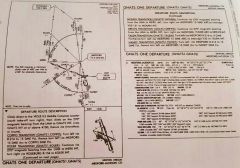
3-3 (Refer to figure 30 on page 2-61) Which restriction to the use of the OED VORTAC would be applicable to the (GNATS1.MOURN) departure? |
R 333 beyond 3ONM below 6,500 feet |
|
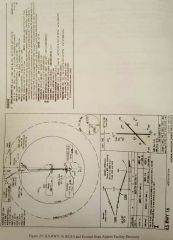
3-4 (Refer to figure 29 on page 3-6) What are the hours of operation (Local Standard time) of the control tower at Eugene/Mahlon Sweet Field? |
0600- 0000 |
|
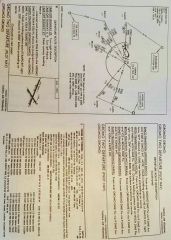
3-5 (Refer to figure 46 on page 2-68) What are the hours of operation (local time) of the ATIS for the Yakima Air Terminal when daylight savings time is in effect? |
0600 to 2200 Local |
|
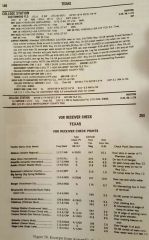
3-6 (Refer to figure 58 on page 2-74)On which frequencies could you communicate with the Montgomery County FSS while on the ground at College station? |
122.65, 122.2 |
|
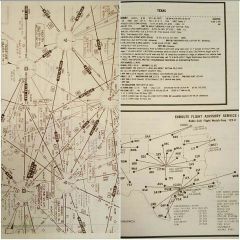
3-7 (Refer to figure 59 on page 3-8 and Figure 60 On page 3-9) What are the operating hours (local standard time) of the Houston EFAS? |
0600 to 2200 |
|
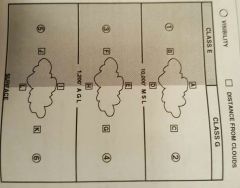
3-22 (Refer to figure 92 on page 3-14)What is the minimum in flight Visibility and distance from clouds required for a VFR-on-Top flight at 9,500 feet MSL (above 1,200 feet AGL)during daylight hours for area 3? |
3 miles; (E) 1,000 feet; (F) 2,000 feet; (H) 500 feet |
|
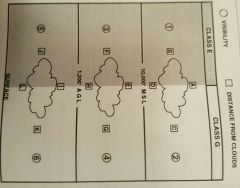
3-23( Refer to figure 92 on page 3-14) A flight is to be conducted in VFR-on-Top conditions at 12,500 feet MSL (above 1200 feet AGL). What is the in-flight visibility and distance from clouds required for operations in class E airspace during daylight hours for area 1? |
5 miles; (A) 1,000 feet;(B) 1 mile; (D) 1,000 feet |
|
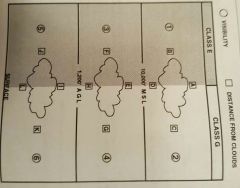
3-24(Refer to figure 92 on page 3-14)What is the minimum in-flight visibility and distance from clouds required in VFR conditions above clouds at 13,500 feet MSL( above 1,200 feet AGL) in class G air space during daylight hours for area 2? |
5 miles; (A) 1,000 feet;(C)1 mile; (D) 1,000 feet. |
|
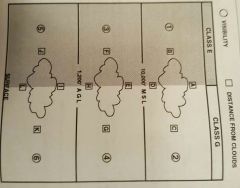
3-25 (Refer to figure 92 on page 3-14) What in flight visibility and distance from clouds is required for a flight at 8,500 feet MSL (above 1,200 feet AGL) in Class G airspace in VFR conditions during daylight hours in area 4? |
1-mile; (E) 1,000 feet; (G) 2,000 feet; (H) 500 feet. |
|
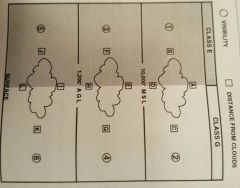
3-26 (Refer to figure 92 on page 3-14) What is the minimum in flight visibility and distance from clouds required for an airplane operating less than 1,200 feet Agl during the daylight hours in area 6? |
1 mile ; (I) Clear of clouds; (k) clear of clouds;4) Clear of Clouds |
|
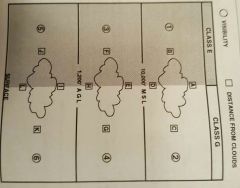
3-27 (Refer to figure 92 on page 3-14) What is the minimum in flight visibility and distance from clouds required for an airplane operating less than 1,200 feet AGL under special VFR during daylight hours in area 5? |
1 mile; (I) clear of clouds; (J) Clear of clouds; (L) clear of clouds. |
|
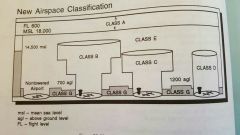
3-28 (Refer to figure 93 on page 3-16.)What is the floor of Class E airspace when designated in Conjunction with an airway? |
1,200 feet AGL |
|

3-29 (Refer to figure 93 on page 3-16.)Which altitude is the normal upper limit for Class D airspace? |
2,500 feet AGL |
|
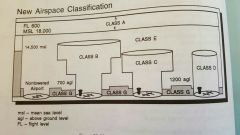
3-30 (Refer to figure 93 on page 3-16) What is the floor of Class E airspace when designated in conjunction with an airport which has an approved IAP? |
700 feet AGL |
|
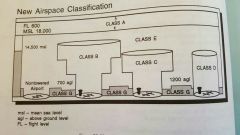
3-31 (Refer to figure 93 on page 3-16) Which altitude is the upper limit for Class A airspace? |
60,000 feet MSL |
|

3-32 (Refer to figure 93 on page 3-16) What is the maximum altitude that Class G airspace will exist (Does not include airspace less than 1,500 feet AGL.) |
14,500 feet MSL |
|
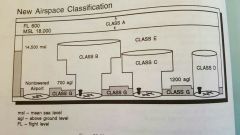
3-33 (Refer to figure 93 on page 3-16) What is generally the maximum altitude for Class B airspace? |
10,000 feet MSL |
|

3-34 (Refer to figure 93 on page 3-16) What is the floor of Class A airspace? |
18,000 feet MSL |
|

3-37 (Refer to figure 134 on page 3-18) Unless a higher angle is necessary for obstacle clearance, what is the normal glide path anglefor a 2-bar VASI? |
3.00° |
|
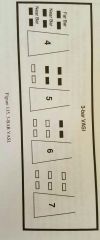
3-45 (Refer to figure 135 on page 3-20) Unless a higher angle is required for obstacle clearance, what is the normal glidepath for a 3-bar VASI? |
3.0° |
|
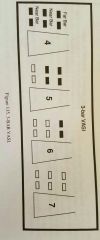
3-46 (Refer to figure 135 on page 3-20.) Which illustration would a pilot observe when on the lower glide path? |
5 |
|
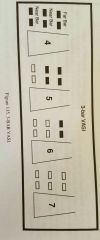
3-47 (Refer to figure 135 On page 3-20) Which illustration Would a pilot observe if the aircraft is above both glide paths? |
7 |
|
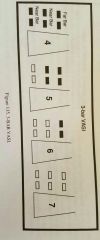
3-48 (Refer to figure 135 on page 3-20.) Which illustration Would a pilot observe if the aircraft is below both glide paths? |
4 |
|

3-49 (Refer to figure 136 on page 3-21) Which illustration depicts an "on glide path" indication? |
10 |
|

3-50 (Refer to figure 136 on page 3-21) Which illustration depicts a "slightly low" (2. 8°) indication? |
11 |
|

3-51 (Refer to figure 136 on page 3-21) Which illustration would a pilot observe if the aircraft is on glidepath higher than 3.5°? |
8 |
|

3-52 (Refer to figure 136 on page 3-21)which illustration would a pilot observe if the aircraft is "slightly high" (3.2°) on the glidepath? |
9 |
|

3-53 (Refer to figure 136 on page 3-21) Which illustration would a pilot observe if the aircraft is less than 2.5°? |
12 |
|

3-54 (Refer to figure 137 on page 3-23.) What is the distance (A) from the beginning of the runway to the fixed distance marker? |
1,000 feet |
|

3-55 (Refer to figure 137 on page 3-23.) What is the distance (B) from the beginning of the runway to the touchdown zone worker? |
500 feet |
|

3-56 (Refer to figure 137 on page 3-23.)What is the distance (c) from the beginning of the touchdown Zone marker to the beginning of the fixed distance marker? |
500 feet |
|

3-60 (Refer to figure 138 on page 3-25) What night operations, if any, are authorized between the approach end of the runway and the threshold lights? |
Taxi and takeoff operations are toward the visible green threshold lights |

